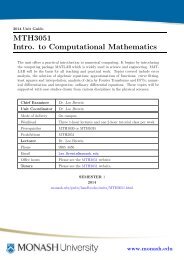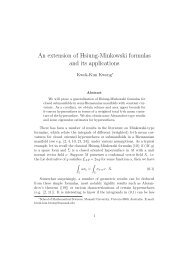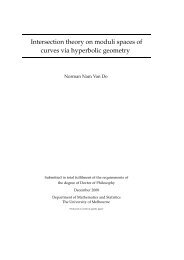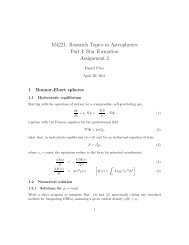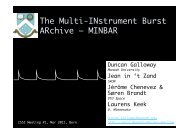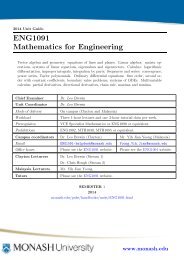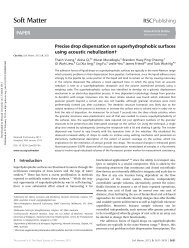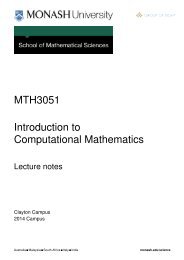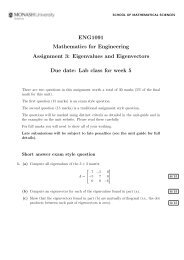A first-order wave equation in modelling the behaviour of epithelial ...
A first-order wave equation in modelling the behaviour of epithelial ...
A first-order wave equation in modelling the behaviour of epithelial ...
Create successful ePaper yourself
Turn your PDF publications into a flip-book with our unique Google optimized e-Paper software.
understand<strong>in</strong>g and build ma<strong>the</strong>matical models <strong>of</strong> <strong>the</strong> underly<strong>in</strong>g<br />
recognized biological phenomena, namely, <strong>the</strong><br />
<strong>behaviour</strong> <strong>of</strong> <strong>the</strong> epi<strong>the</strong>lial cells on <strong>the</strong> surface <strong>of</strong> <strong>the</strong><br />
posterior capsule which obscures <strong>the</strong> back surface <strong>of</strong> <strong>the</strong><br />
implanted lens.<br />
In our work we will assume that <strong>in</strong>tensity <strong>of</strong> <strong>the</strong> PCO<br />
images is a measure <strong>of</strong> concentration <strong>the</strong> <strong>of</strong> epi<strong>the</strong>lial<br />
cells.<br />
@u @t=cgd(x;t)<br />
3. THE FIRST-ORDER WAVE EQUATION AND<br />
ITS COMPUTER MODELLING<br />
A simple <strong>first</strong> <strong>order</strong> <strong>wave</strong> <strong>equation</strong>, which describes movement<br />
<strong>in</strong> <strong>the</strong> directiondcan be written <strong>in</strong> <strong>the</strong> follow<strong>in</strong>g<br />
form:<br />
(3)<br />
gd(x;t)=dTru(x;t) (4)<br />
u(x;t+1)=u(x;t)+ctsjjru(x;t)jj<br />
experimentation we usen=4,l=3and=0:3. The<br />
(8)<br />
result<strong>in</strong>g discretised <strong>wave</strong> <strong>equation</strong> (7) takes <strong>the</strong> follow<strong>in</strong>g<br />
form:<br />
whereris a filtered gradient operation as described<br />
above. Note also <strong>the</strong> change <strong>of</strong> sign <strong>in</strong> <strong>order</strong> to be consistent<br />
with <strong>the</strong> usual notation <strong>in</strong> our class <strong>of</strong> images.<br />
In Figure 2 we demonstrate <strong>the</strong> <strong>behaviour</strong> <strong>of</strong> <strong>the</strong> <strong>wave</strong><br />
<strong>equation</strong> (8) <strong>in</strong> a one-dimensional case.<br />
1<br />
0.8<br />
0.6<br />
0.4<br />
<strong>in</strong>tensity<br />
u=u(dTxct)<br />
@u @t=cdu dv;ru=ddu<br />
andcis <strong>the</strong> speed <strong>of</strong> <strong>wave</strong> propagation. In <strong>order</strong> to show<br />
that<br />
(5)<br />
is a solution <strong>of</strong> eqn (3), we differentiate (3) with respect<br />
to time and space to obta<strong>in</strong><br />
gd=gTg<br />
from which <strong>the</strong> result follows immediately.<br />
In this paper we concentrated on modell<strong>in</strong>g <strong>the</strong> movement<br />
<strong>of</strong> <strong>the</strong> cell concentration <strong>in</strong> <strong>the</strong> direction <strong>of</strong> <strong>the</strong> concentration<br />
gradient.<br />
@u jjgjj=jjgjj<br />
@t=cjjg(x;t)jj<br />
In this case <strong>the</strong> projection <strong>of</strong> <strong>the</strong><br />
gradient on <strong>the</strong> direction <strong>of</strong> movement can be expressed<br />
as:<br />
(6)<br />
and <strong>the</strong> modell<strong>in</strong>g <strong>equation</strong> becomes<br />
(7)<br />
wherejjgjjis <strong>the</strong> gradient magnitude.<br />
In <strong>order</strong> to perform computer modell<strong>in</strong>g, eqn (7) needs<br />
to be discretised <strong>in</strong> <strong>the</strong> temporal and spatial doma<strong>in</strong>s.<br />
The time derivative is approximated by a simple backward<br />
time difference. As far as <strong>the</strong> gradient is concerned,<br />
it is important for real life images to calculate<br />
it us<strong>in</strong>g an appropriate low-pass filter. Most suitable<br />
for <strong>the</strong> purpose is an edge filter from <strong>the</strong> class <strong>of</strong> filters<br />
commonly referred to as Canny operators [10]. For<br />
our images, with very s<strong>of</strong>t edges we use a Petrou-Kittler<br />
edge filter [11] as described <strong>in</strong> [7] which is optimised<br />
for ramp edges. Such an edge operator is characterised<br />
by three parameters, namely, a number <strong>of</strong> filter<strong>in</strong>g directions,n,<br />
radial span,l, and angular overlap,. In our<br />
1.2<br />
1<br />
0.8<br />
0.6<br />
0.4<br />
0.2<br />
0<br />
0 10 20 30 40 50 60<br />
Figure 2: One-dimensional <strong>wave</strong> <strong>equation</strong><br />
The <strong>in</strong>itial distribution,u(x;0)and its gradientg(x;0)<br />
is marked with ’o’. Note that <strong>the</strong> fronts <strong>of</strong> <strong>the</strong> functions<br />
move accord<strong>in</strong>g to <strong>the</strong> value <strong>of</strong> gradient.<br />
For <strong>the</strong> real two-dimensional case results are presented<br />
<strong>in</strong> Figure 3. Images were down-sampled by <strong>the</strong><br />
factor <strong>of</strong> five, <strong>in</strong> <strong>order</strong> to reduce <strong>the</strong> size <strong>of</strong> <strong>the</strong> relevant<br />
postscript files.<br />
The <strong>first</strong> image represents <strong>the</strong> <strong>in</strong>itial concentration<br />
<strong>of</strong> cells. The boundary conditions are set so that <strong>the</strong><br />
cell concentration outside <strong>the</strong> lens’ disk is kept constant,<br />
namely,u=1, which is represented by <strong>the</strong> black colour<br />
<strong>in</strong> <strong>the</strong> images <strong>of</strong> Figure 3. With reference to eqns (7)and<br />
(8)<strong>the</strong> essential <strong>behaviour</strong> <strong>of</strong> <strong>the</strong> algorithms can be described<br />
as follows. Consider a ridge <strong>of</strong> cell concentration.<br />
The gradient <strong>of</strong> <strong>the</strong> top part <strong>of</strong> <strong>the</strong> ridge is zero<br />
which makes <strong>the</strong> position <strong>of</strong> <strong>the</strong> ridge is ma<strong>in</strong>ta<strong>in</strong>ed constant.<br />
For <strong>the</strong> slopes <strong>of</strong> <strong>the</strong> ridge, <strong>the</strong> magnitude <strong>of</strong> gradient<br />
is non-zero, which results <strong>in</strong> <strong>the</strong> slopes be<strong>in</strong>g flatten<br />
by mov<strong>in</strong>g <strong>the</strong>m apart. This elementary <strong>behaviour</strong> is<br />
comb<strong>in</strong>ed for each mound <strong>of</strong> cells to result <strong>in</strong> <strong>the</strong> emerg<strong>in</strong>g<br />
<strong>behaviour</strong> as observed <strong>in</strong> Figure 3. The islands <strong>of</strong><br />
cells are separated by flat grooves where gradient is zero<br />
or very small.<br />
It must be emphasized, however, that eqn (7) does<br />
not explicitly describe <strong>the</strong> growth or regression <strong>of</strong> cells,<br />
hence, <strong>the</strong> obta<strong>in</strong>ed patterns are poorer than that observed<br />
<strong>in</strong> <strong>the</strong> natural images.<br />
dressed <strong>in</strong> our future works.<br />
This issue will be ad-<br />
0.2<br />
wheregd(x;t)is <strong>the</strong> projection <strong>of</strong> <strong>the</strong> gradient <strong>of</strong> cell<br />
concentrationg=ru<strong>in</strong> <strong>the</strong> directiond, namely,<br />
0<br />
0 10 20 30 40 50 60<br />
1.4<br />
magnitude <strong>of</strong> gradient



